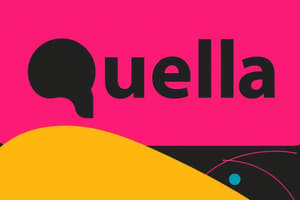Podcast
Questions and Answers
ما هو تعريف موارد التعليم المفتوح؟
ما هو تعريف موارد التعليم المفتوح؟
- موارد التعليم التي لا يمكن الاستغلال ولا يمكن استخدامها знову
- موارد التعليم التي تكون مربحة ماليًا
- موارد التعليم التي تكون مصاحبة لمنهج التعليم التقليدي
- موارد التعليم التي تكون متاحة ومفتوحة للاستخدام والتحويل والتبادل (correct)
ما هي السمات الرئيسية لموارد التعليم المفتوح؟
ما هي السمات الرئيسية لموارد التعليم المفتوح؟
- مغلقة المصدر والرخصة مفتوحة vàمرهقة التكلفة
- مغلقة المصدر والرخصة مغلقة ومرهقة التكلفة
- مغلقة المصدر ومرهقة التكلفة وغير قابلة للتUSTOMIZATION
- مفتوحة المصدر والرخصة مفتوحة ومجانية أو منخفضة التكلفة وقابلة للتUSTOMIZATION (correct)
ما هو نوع مورد التعليم المفتوح؟
ما هو نوع مورد التعليم المفتوح؟
- الكتاب المدرسي ولا يوجد كتاب جامعي
- الكراسات والكتب المدرسية والكتب الجامعية
- الكراسات والكتب المدرسية والكتب الجامعية وغيرها من موارد التعليم المفتوحة (correct)
- الكتب المدرسية والكتب الجامعية
ما هي فوائد مورد التعليم المفتوح؟
ما هي فوائد مورد التعليم المفتوح؟
ما هو الهدف من استخدام موارد التعليم المفتوح؟
ما هو الهدف من استخدام موارد التعليم المفتوح؟
Flashcards are hidden until you start studying
Study Notes
Open Educational Resources (OER)
Definition
- Open Educational Resources (OER) are educational materials that are freely available, accessible, and customizable for use, modification, and sharing.
Characteristics
- Openly licensed: OER are released under licenses that allow users to retain, reuse, revise, remix, and redistribute the materials.
- Free of cost: OER are available at no cost or low cost, reducing barriers to access.
- Customizable: OER can be adapted to meet the needs of different learners, instructors, and contexts.
Types of OER
- Textbooks: Openly licensed digital textbooks that can be customized and adapted.
- Course materials: Lecture notes, slides, and assignments that are openly available.
- Images and videos: Openly licensed multimedia resources that can be used in educational contexts.
- Software and tools: Open-source software and tools that support teaching and learning.
Benefits of OER
- Increased accessibility: OER can reach a wider audience, including those who may not have had access to educational resources due to cost or geographical barriers.
- Improved quality: OER can be reviewed and improved by a community of users, leading to higher quality materials.
- Cost savings: OER can reduce the cost of education for students and institutions.
- Flexibility and customization: OER can be adapted to meet the needs of different learners and instructors.
Challenges and limitations of OER
- Quality control: Ensuring the quality of OER can be a challenge, as anyone can create and share materials.
- Discovery and adoption: Finding and adopting OER can be time-consuming and require significant effort.
- Sustainability: Ensuring the long-term sustainability of OER initiatives and repositories can be a challenge.
- Cultural and linguistic barriers: OER may not be accessible or relevant to all learners, particularly those from diverse cultural and linguistic backgrounds.
Studying That Suits You
Use AI to generate personalized quizzes and flashcards to suit your learning preferences.




